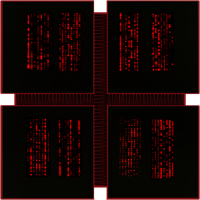Tamiko Thiel:
The Connection Machine
o Main Page
o CM Legacy: Technology
o CM-1/CM-2 Design Legacy
o Articles
o Image Galleries
o "Feynman"
CM-1 T-shirt
[ Email
]
[ Portfolio
]
 |
Connection Machines Legacy: Technology |
 |
The CM Legacy project explores how concepts, software and hardware developed for the Connection Machines (CM-1, CM-2 and its successor CM-5) have influenced the explosion in artificial intelligence and parallel computing that we are experiencing today, long after Thinking Machine Corp.'s demise in 1996.
Below are exploratory interviews with several former TMC colleagues to understand how they see the legacy of their work in that time, and how it has formed their own activities today.
Danny Hillis, August 2016
In which Danny talks about how Sergey Brin, Google, the Internet, the Cloud and GPUs realized his dreams for massively parallel computing. Danny was the inventor of the Connection Machines and Chief Scientist of Thinking Machine Corporation, the company he co-founded to build the machine.
See also his brief description of how he sees AI now (2017)
Total interview is ~40 minutes over 5 videos. For subtitles click on icon lower middle-right.
Click playlist menu in upper left of video to see other topics.
View video on YouTube for extensive links on topics and people mentioned in the videos.
Download a pdf of the transcript.
Brewster Kahle, September 2016
A conversation between Brewster and Tamiko on how he helped architect the Connection Machine to be the first supercomputer that could handle his life-long passion: Big Data. For example, the searches we do so easily every day on the Internet - just typing in words, and seeing where they occur even in the middle of texts - first were possible on the Connection Machine. Brewster helped start Thinking Machines Corp. and was lead engineer on the Connection Machine. His Wide Area Information Servers (WAIS) were pre-Web Internet search services, and his Internet Archive is inspired by the Library of Alexandria, seeking to make the knowledge of the entire world available on the Internet.
Total interview is ~40 minutes over 5 videos. For subtitles click on icon lower middle-right.
Click playlist menu in upper left of video to see other topics.
View video on YouTube for extensive links on topics and people mentioned in the videos.
Lew Tucker, September 2016
Lew Tucker, currently CTO of Cloud Computing at Cisco Systems, was Director of Advanced Development at Thinking Machines and with Danny Hillis co-architect of the CM-5 (1991), the CM-2's successor with a completely different form and computer architecture.
When Thinking Machines began in 1983, parallel programming was widely considered too difficult to be useful. The CM-1 and CM-2 were built as a Single Instruction Multiple Data (SIMD) machines, in which at any given step all processors executed the same instruction but on their own data, in order to work on Big Data problems intractable to serial supercomputers and gain experience in thinking in terms of parallel processes. The experiences of many scientists working with these machines enabled Thinking Machines to bring out the CM-5 in 1991 with more powerful processors that could function in both SIMD and a MIMD mode (Multiple Instruction Multiple Data) mode, in which different processors could work on different instructions.
With the demise of Thinking Machines in 1996 much knowledge of parallel programming techniques faded out of use, and are only slowly being rediscovered as parallel programming becomes increasingly important again today.
In the video interview, Lew talks about how his interest in neurophysiology originally led him to join Thinking Machines, and how their vision for the Connection Machine is now realized in the Cloud.
Total interview is ~55 minutes over 5 videos. For subtitles click on icon lower middle-right.
Click playlist menu in upper left of video to see other topics.